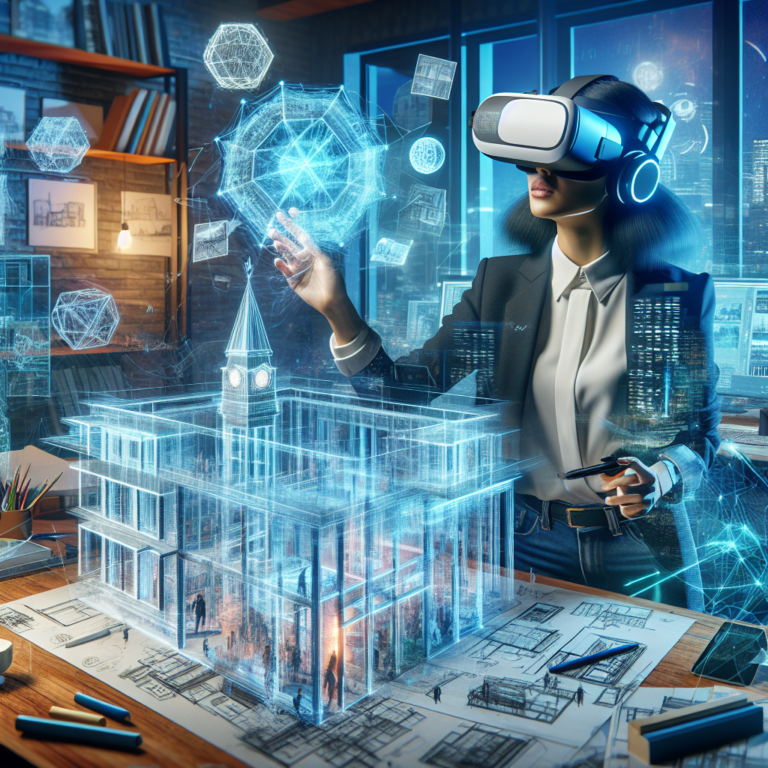Revolutionizing Design: How Immersive Technologies are Transforming Architecture
The Digital Renaissance in Architecture: Embracing Virtual Reality
Immersive technologies, particularly Virtual Reality (VR), are reshaping the landscape of architecture by revolutionizing how architects design and visualize their creations. Gone are the days of strictly relying on two-dimensional blueprints and static 3D models; now, architects have the power to create dynamic, immersive experiences that transport clients right into the heart of their designs. 🌍
Understanding the Benefits of Virtual Reality in Architecture
The integration of VR technology into architectural design offers a plethora of benefits that enhance the overall design process. Here are some key advantages:
- Immersive Experiences: VR allows architects to create fully immersive environments, enabling clients to navigate through spaces as if they were physically present. This leads to a much richer understanding of scale, proportion, and spatial relationships.
- Enhanced Decision Making: By experiencing designs in various lighting conditions and angles, architects can identify potential design flaws and spatial inefficiencies more effectively.
- Improved Communication: The need for complex explanations of 2D drawings diminishes as clients can directly engage with the immersive models, leading to quicker feedback and collaborative discussions.
- Cost Reduction: Utilizing VR for design iterations can lead to significant cost savings as potential issues can be detected early, reducing the need for expensive changes during construction.
- Streamlined Approval Processes: Immersive technology accelerates stakeholder approval by providing compelling visualizations that resonate with clients and investors.
Immersive Technologies in Action
Architects are increasingly harnessing the power of various immersive technologies. While VR is the front-runner, other forms like Augmented Reality (AR) and Mixed Reality (MR) are gaining traction. Let’s explore how these technologies are utilized:
1. Virtual Reality (VR)
VR enables architects to create digital renditions of their projects that clients can walk through. Notable applications include:
- Real-Time Design Changes: Architects can make alterations on the fly based on client feedback, showcasing how those changes affect the overall design.
- Interactive Walkthroughs: Clients can explore spaces before they are built, experiencing layout, flow, and lighting firsthand.
- Construction Simulation: VR can simulate the entire construction process, enhancing planning and safety measures.
2. Augmented Reality (AR)
While VR immerses users in a virtual space, AR overlays digital elements onto the real world. This technology proves invaluable for:
- Site Analysis: Real-world environments can be augmented with digital mappings of proposed designs, providing clarity on site integration.
- Collaborative Design Visualization: Teams can interact with 3D models in real time on-site, facilitating immediate changes and fostering teamwork.
3. Mixed Reality (MR)
MR combines the best of VR and AR, allowing architects to blend digital models with the real world seamlessly. Key benefits include:
- Enhanced Communication: MR fosters improved understanding among project stakeholders by showing exactly how designs will resonate within their intended context.
- Project Management: Using MR aids in visualizing schedules, plans, and next steps directly onto real-world environments, enhancing the overall project workflow.
Success Stories: Immersive Technology in Action
Many architectural firms have embraced immersive technologies with remarkable outcomes. For instance, powerful project examples include:
Foster + Partners
This acclaimed architecture firm utilizes VR to enhance client presentations, allowing stakeholders to experience their designs fully. This not only significantly improves client engagement but also leads to quicker approvals.
Zaha Hadid Architects
Known for pushing the boundaries of design, Zaha Hadid Architects employs VR for construction simulations and project planning. This forward-thinking approach streamlines communication and enhances safety on-site, transforming their design process.
Overcoming Challenges: Integrating Immersive Tech into Existing Processes
Despite the growing acceptance of immersive technologies in architecture, challenges remain. Some include:
- Resistance to Change: Some subcontractors and stakeholders may hesitate to adopt VR and AR due to unfamiliarity or a perceived lack of applicability.
- Resource Intensive: Implementing immersive technologies can require significant resource allocation for training, technology upgrades, and integration into existing workflows.
- Perceived Use Cases: Many still view immersive technologies primarily for marketing rather than as integral tools in the design process.
A Vision for the Future: The Role of Immersive Technologies
Architects envision a future where immersive technologies continue to transform the design process into a more iterative, educational experience. Here’s how:
- Prototyping and Testing: With VR, architects can prototype and test designs in a virtual environment, allowing for a rapid test-and-learn loop.
- Storytelling: Like the gaming industry, architects can harness the narrative elements of immersive experiences to convey design intent compellingly.
- Transformative Impact: The combination of immersive technologies with evolving building intelligence offers the potential for societal impacts, influencing urban environments and lifting design standards.
Adapting to the Changing Tide of Technology
As immersive technologies continue to advance, architects who embrace these tools can redefine their approach to design. By stepping into virtual environments, understanding the potentials of digital integrations, and continuously iterating based on real-time feedback, the possibilities are limitless.
Architects can unlock new pathways, exploring innovative design opportunities that reshape space, enhancing their ability to communicate, collaborate, and create. 🌟
The Next Steps for Architects
To thrive in this evolving landscape, architects should consider:
- Investing in Training: Equip teams with knowledge and skills in immersive technologies to integrate them effectively into workflows.
- Experimenting with Tools: Explore various VR, AR, and MR solutions to identify the best fits for specific project needs.
- Engaging Clients: Use immersive experiences as a bridge to better client engagement, turning their visions into reality.
With immersive technologies at their fingertips, architects are not just building structures; they are shaping the future of human environments, experiences, and communities. 🏗️




0 Comments